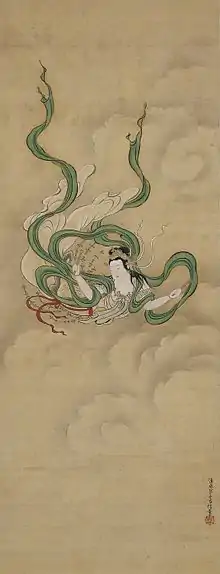Kiyohara Yukinobu
Kiyohara Yukinobu (1643–1682) was a Japanese painter and one of the foremost women identified with the Kanō school. Her father Kusumi Morikage was also a painter and her mother Kuniko was the niece of his longtime teacher and patron Kanō Tan'yū. Yukinobu lived in Kyoto and likely studied under her father. Her work covered a wide variety of formats ranging from small scrolls to large screens. Thematically she was skilled in the Yamato-e style but was also notable for producing many works depicting women including legendary figures such as Murasaki Shikibu.[2][3]:219, 232–233 Because many of Yukinobu's works are signed and sealed with her name, it suggests she had achieved enough recognition to receive commissions from middle class townspeople and samurai. A pair of her screens, Birds and Flowers of the Four Seasons (late 17th – early 18th century) was shown publicly for the first time in 2015 as part of an exhibition at the Kosetsu Memorial Museum in Tokyo.[4]
Kiyohara Yukinobu | |
|---|---|
| Born | 1643 Kyoto, Japan[1] |
| Died | 1682 (aged 38–39) |
| Nationality | Japanese |
| Known for | Painting |
| Movement | Kanō school |

Ihara Saikaku's The Life of an Amorous Woman includes a story in which a courtesan commissions a work from Yukinobu.[2][3]:242
References
- Phaidon Editors (2019). Great women artists. Phaidon Press. p. 217. ISBN 978-0714878775.
- Fister, Patricia (1988). Japanese Women Artists 1600–1900. Lawrence, Kansas: Spencer Museum of Art, University of Kansas. pp. 34–35. ISBN 0-913689-25-4.
- Weidner, Marsha Smith, ed. (1990). Flowering in the Shadows: Women in the History of Chinese and Japanese Painting. University of Hawaii Press. ISBN 9780824811495.
- "Gordenker, Alice, "Painting Women of Japan" | The Japan Times". The Japan Times. Retrieved 2018-03-07.
External links
 Media related to Kiyohara Yukinobu at Wikimedia Commons
Media related to Kiyohara Yukinobu at Wikimedia Commons